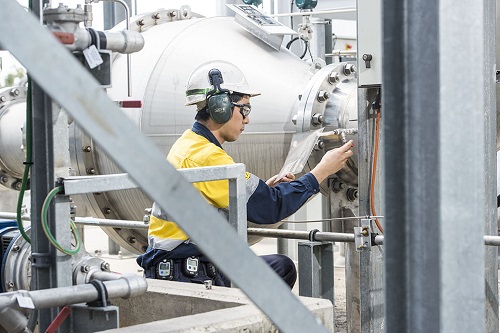Insights and Commentaries
International partnerships help innovate Callide Oxyfuel Project
15th July 2015
Topic(s): Carbon capture, Economics, Engineering and project delivery, use and storage (CCUS)
The Callide Oxyfuel Project in central Queensland, Australia ran in demonstration phase from June 2012 to March 2015. The project has produced valuable data on oxyfuel combustion processes and technology for retrofitting to coal-fired power stations. This second Insight by Project Director, Dr Chris Spero follows his earlier article describing the Callide project. In this Insight Chris highlights the successful partnerships and international collaboration that made it happen.

Takahiro Goto from IHI takes gas samples at different power station loads, during the final weeks of the project. This data collected by IHI informs partners of the nature of the oxyfuel carbon capture process when the power station is run at different loads. Photo courtesy of Callide Oxyfuel Project.
The successful Callide Oxyfuel Project, a world-first demonstration of oxyfuel and carbon capture technology, is an exceptional example of how international collaboration and partnership can work towards demonstrating practical and adaptable CCS technology to help tackle climate change globally.
As an Australian-Japanese collaboration, the Callide Oxyfuel Project was led by an international joint venture, and effectively combined the individual strengths of its partners to navigate through the research, development, construction and demonstration phases of the project.
The Calllide Oxyfuel Project joint venture partners included:
- CS Energy (Australia)
- ACA Low Emissions Technologies (ACALET, Australia)
- Glencore (Australia)
- Schlumberger Carbon Services (Australasia)
- J-Power (Japan)
- Mitsui & Co.(Japan)
- IHI Corporation (Japan).
The AU$245 million project was awarded AU$63 million from the Australian Government under the Low Emissions Technology Demonstration Fund. The Callide Oxyfuel Project has also received financial support from the Japanese and Queensland Governments and technical support from the Japan Coal Energy Centre, JCOAL.
The project was also supported by a number of research and development (R&D) organisations in both Australia and Japan including:
Australia
- Australian National Low Emissions Coal R&D (ANLEC)
- CO2CRC - University of Newcastle
- Macquarie University.
Japan
- New Energy and Industrial Technology Development Organisation (NEDO)
- Ministry of Energy, Trade and Industry (METI).
From its inception, the Callide Oxyfuel Project received significant international interest and recognition. In 2004, a Working Group was established under the umbrella of Australia’s COAL21, the CRC for Coal in Sustainable Development and Japan’s New Energy and Industrial Technology Development Organisation (NEDO), to undertake a prefeasibility study on the project. Since then the Australian-Japanese partnership has grown stronger and is testament to the successful outcome of the project.
In 2006, the Callide Oxyfuel Project was recognised as having international significance when it was announced as a flagship project of the Asia Pacific Partnership on Clean Development and Climate. This raised the profile of the project among APP partners, including Australia, Canada, China, India, Japan, Korea and the United States.
The Callide Oxyfuel Project Management and Technical Committee has participated in the review of international standards relating to CCS, including
- ISO/TC265 N090 (Ref ISO/DTR 27912) Carbon dioxide capture systems, technologies, equipment and processes for power and industry
- Review of American Society of Mechanical Engineers (ASME): Power Test Code PTC 48, Overall Plant Performance with Carbon Capture.
The site of the Callide Oxyfuel Project, the Callide A Power Station near Biloela in Central Queensland Australia, has also hosted a large number of visitors interested in seeing the project in action. Since August 2009, there have been 4,115 visitors to the Callide Oxyfuel Project. Of these visitors, 284 have been international visitors, including key representatives from:
- International Energy Agency (IEA)
- Japanese Universities and research institutions
- Japanese Ministry for Economy, Trade and Industry
- Japanese Chamber of Commerce
- Washington University in St. Louis
- FutureGen 2.0.